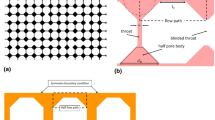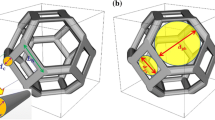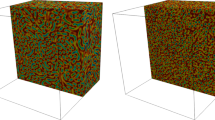Abstract
This study uses experimental data of pore-scale foam flow inside a high-complexity network to fit a graph-based model describing preferential flow paths using microstructural characteristics of the porous medium. Two experiments, with equal gas fractions but varying injection rates, are modeled in parallel. Proposed paths are solution paths to the k-Shortest Paths with Limited Overlap (k-SPwLO) problem, applied to a graph representation of the porous medium with edge weights representing local throat properties. A 1-parameter model based on throat radius only is tested before integrating a second parameter, describing the alignment of the pores surrounding the throat with respect to the injection pressure gradient. The preferential paths observed in both experiments differ in quantity and with respect to the specific porous zones used. As such, the best fit preferential path models for either experiment show different dependencies on the microstructural parameters. The optimized model for the high injection rate experiment markedly shows a dependence on the pore alignment with pressure gradient as well as throat size, whereas the lower injection rate experiment was best fitted to a model that only includes the throat radius. Overall, the graph-based framework was able to capture many high-flow zones in various model parameter combinations, perhaps as consequence of the relatively spiked throat size distribution of the model.




















Similar content being viewed by others
References
Alvarez, J.M., Rivas, H.J., Rossen, W.R.: Unified model for steady-state foam behavior at high and low foam qualities. SPE J. 6(03), 325–333 (2001). https://doi.org/10.2118/74141-PA
Chondrogiannis, T., Bouros, P., Gamper, J., Leser, U.: Exact and approximate algorithms for finding k-shortest paths with limited overlap. In: 20th International Conference on Extending Database Technology: EDBT, pp. 414-425 (2017).
Dijkstra, E.W.: A note on two problems in connexion with graphs. Numer. Math. 1(1), 269–271 (1959). https://doi.org/10.1007/BF01386390
Ettinger, R.A., Radke, C.J.: Influence of texture on steady foam flow in berea sandstone. SPE Reserv. Eng. 7(01), 83–90 (1992). https://doi.org/10.2118/19688-PA
Gassara, O., Douarche, F., Braconnier, B., Bourbiaux, B.: Equivalence between semi-empirical and population-balance foam models. Transp. Porous Med. 120(3), 473–493 (2017). https://doi.org/10.1007/s11242-017-0935-8
Géraud, B., Jones, S.A., Cantat, I., Dollet, B., Méheust, Y.: The flow of a foam in a two-dimensional porous medium. Water Resour. Res. 52(2), 773–790 (2016). https://doi.org/10.1002/2015WR017936
Nussbaum-Krammer, C.I., Neto, M.F., Brielmann, R.M., Pedersen, J.S., Morimoto, R.I.: Investigating the spreading and toxicity of prion-like proteins using the metazoan model organism C elegans. J. Vis. Exp. 95, 52321 (2015). https://doi.org/10.3791/52321s
Rizzo, C.B., Barros, F.P.J.: Minimum hydraulic resistance and least resistance path in heterogeneous porous media. Water Resour. Res. 53(10), 8596–8613 (2017). https://doi.org/10.1002/2017WR020418
Soille, P., Vincent, L. M.: Determining watersheds in digital pictures via flooding simulations. In: Murat K. (ed.). Lausanne - DL tentative. Lausanne, Switzerland, Monday 1 October 1990: SPIE (SPIE Proceedings), pp. 240–250 (1990)
Tanyeri, M., Ranka, M., Sittipolkul, N., Schroeder, C.M.: A microfluidic-based hydrodynamic trap. Design and implementation. Lab Chip 11(10), 1786–1794 (2011). https://doi.org/10.1039/c0lc00709a
Viswanathan, H.S., Hyman, J.D., Karra, S., O'Malley, D., Srinivasan, S., Hagberg, A., Srinivasan, G.: Advancing graph-based algorithms for predicting flow and transport in fractured rock. Water Resour. Res. 54(9), 6085–6099 (2018). https://doi.org/10.1029/2017WR022368
Yeates, C.; Youssef, S.; Lorenceau, E.: New insights of foam flow dynamics in high-complexity 2D micromodels. In: Colloids and Surfaces A: Physicochemical and Engineering Aspects (2019). https://doi.org/10.1016/j.colsurfa.2019.04.092
Yen, J.Y.: An algorithm for finding shortest routes from all source nodes to a given destination in general networks. Quart. Appl. Math. 27(4), 526–530 (1970). https://doi.org/10.1090/qam/253822
Funding
The funding was provided by IFP Energies Nouvelles.
Author information
Authors and Affiliations
Corresponding author
Additional information
Publisher's Note
Springer Nature remains neutral with regard to jurisdictional claims in published maps and institutional affiliations.
Appendices
Appendix 1: Porous Network and Extracted Graph
Regarding the structural parameters used for the weights of the edges connecting the artificial inlet/outlet nodes to the rest of the network, the throat size for each edge was trivially given by the throat that connected the network to the inlet/outlet zone. However, the angle µ that shows the pore-to-pore alignment with pressure gradient was set equal to 0 (perfect alignment with gradient) for all nodes connected to either to inlet or outlet nodes. Indeed, as the center of mass of the inlet and outlet nodes are positioned in the central axis, taking the alignment angle with this position would create erroneous bias against pores outwards from the central axis (Fig. 21).
Appendix 2: Full Model Experimental Match of Proposed Paths
Here, we give two examples of full model flowmaps overlaid with the paths for the best models for each experiment.
In Fig. 22, we show the best model for Exp. 1: \(\left( {\alpha ,\beta } \right) = \left( {2.2,0.6} \right)\) with a high intensity threshold on the pore activity classification. Flow intensity is shown in grayscale within the porous network.
Experiment 1 high intensity threshold best model proposed paths. The color code is given in Fig. 8. Flow is from top to bottom
In Fig. 23, we show the best model for Exp. 2: \(\left( {\alpha ,\beta } \right) = \left( {1.2,0} \right)\) with a high intensity threshold on the pore activity classification.
Experiment 2 high intensity threshold best model proposed paths. The color code is given in Fig. 8. Flow is from top to bottom
Appendix 3: Comparison Between Models Minimizing Path Distance and Number of Pores
In Fig. 24, we show the first 5 proposed paths in two types of models used in Fig. 13: the model minimizing the total physical distance (red crosses in Fig. 13) and the model minimizing the number of pores (green plusses in Fig. 13). The velocity intensity of Exp. 1 with flow from top to bottom is shown in grayscale within the porous area for comparison.
Comparison of proposed paths for different models used in Fig. 13. The paths in light green are proposed by the model minimizing physical distance, whereas the paths in light blue are proposed by the model minimizing the number of pores. The areas in dark blue are common to both sets of paths
Rights and permissions
About this article
Cite this article
Yeates, C., Youssef, S. & Lorenceau, E. Accessing Preferential Foam Flow Paths in 2D Micromodel Using a Graph-Based 2-Parameter Model. Transp Porous Med 133, 23–48 (2020). https://doi.org/10.1007/s11242-020-01411-2
Received:
Accepted:
Published:
Issue Date:
DOI: https://doi.org/10.1007/s11242-020-01411-2








